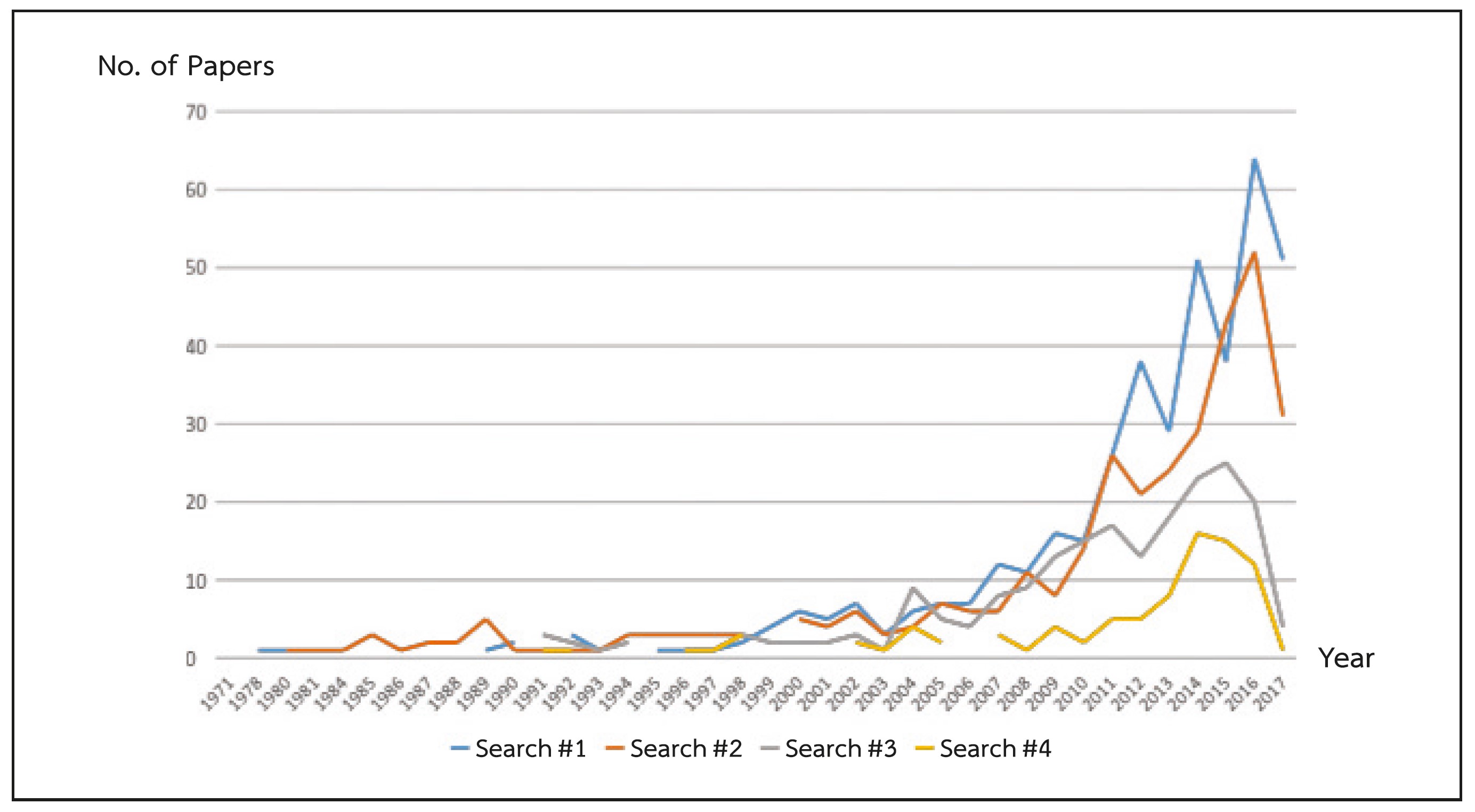การพัฒนาตัวชี้วัดสำหรับการประเมินความเสี่ยงในโลจิสติกส์
คำสำคัญ:
ตัวชี้วัด, ความเสี่ยง, โลจิสติกส์, การวิเคราะห์ปัจจัย, ดัชนีรวมบทคัดย่อ
งานวิจัยนี้มีวัตถุประสงค์เพื่อพัฒนาตัวชี้วัดสำหรับการประเมินความเสี่ยงในโลจิสติกส์ โดยใช้การทบทวนวรรณกรรมเพื่อสืบค้นงานวิจัยที่มีการศึกษาความเสี่ยงในการจัดการโลจิสติกส์จากฐานข้อมูลด้านการบริหารธุรกิจและการจัดการ เพื่อทำการรวบรวมประเด็นความเสี่ยงในโลจิสติกส์ และประยุกต์ใช้วิธีการวิเคราะห์ปัจจัย เพื่อคัดกรองและจัดกลุ่มตัวชี้วัด แล้วจึงทำการวิเคราะห์ค่าถ่วงน้ำหนักของตัวชี้วัดเพื่อนำมาสร้างดัชนีรวมสำหรับใช้ประเมินภาพรวมของความเสี่ยงในโลจิสติกส์ขององค์กร โดยผลการวิเคราะห์ปัจจัยสามารถแบ่งกลุ่มตัวชี้วัดออกเป็น 9 ปัจจัย 61 ตัวชี้วัด โดยปัจจัยความเสี่ยงด้านข้อมูลมีความสำคัญมากที่สุด ตามมาด้วยด้านการจัดการ และด้านการขนส่ง ชุดตัวชี้วัดและดัชนีรวมที่พัฒนาขึ้นได้ถูกนำไปทดลองใช้กับกลุ่มตัวอย่างที่เป็นบริษัทโลจิสติกส์ โดยผลการทดสอบพบว่าชุดตัวชี้วัดสำหรับประเมินความเสี่ยงในโลจิสติกส์มีความครอบคลุม เหมาะสม และสะดวกต่อการนำไปใช้งานจริง นอกจากการนำไปประเมินความเสี่ยงในโลจิสติกส์ขององค์กร ประโยชน์ของการพัฒนาชุดตัวชี้วัดในงานวิจัยนี้ คือ การสร้างการตระหนักรู้ด้านความเสี่ยงต่างๆในโลจิสติกส์ให้แก่ผู้ประกอบการ เพื่อใช้ตรวจสอบและวางแผนสำหรับเตรียมความพร้อมในการรับมือกับความเสี่ยงในโลจิสติกส์ ที่ปัจจุบันผู้ประกอบการไทยยังให้ความสำคัญในระดับต่ำ
เอกสารอ้างอิง
Asif, M., & Searcy, C. (2014). A composite index for measuring performance in higher education institutions. International Journal of Quality & Reliability Management, 31(9), 983-1001. https://doi.org/10.1108/IJQRM-02-2013-0023
Bandaly, D., Satir, A., Kahyaoglu, Y., & Shanker, L. (2012). Supply chain risk management-I: Conceptualization, framework and planning process. Risk Management, 14(4), 249-271. https://doi.org/10.1057/rm.2012.7
Beasley, M. S., Branson, B. C., & Hancock, B. V. (2010). Developing key risk indicators to strengthen enterprise risk management. Raleigh: ERM Initiative at North Carolina State University and the Committee of Sponsoring Organizations of the Treadway Commission.
Bi, K., Huang, P., & Ye, H. (2015). Risk identification, evaluation and response of low-carbon technological. Technological Forecasting and Social Change, 100, 238-248. https://doi.org/10.1016/j.techfore.2015.07.005
Choi, T., Chiu, C., & Chan, H. (2016). Risk management of logistics systems. Transportation Research Part E: Logistics and Transportation Review, 90, 1-6. https://doi.org/10.1016/j.tre.2016.03.007
Cirjaliu, B., Weinschrott, H., Gaureanu, A., & Boatca, E. M. (2016). A Proposal for a Risk Assessment Management in a Transport Company. (pp. 229-234). Rome: Elsevier B.V. https://doi.org/10.1016/S2212-5671(16)30317-3
Coleman, M.E., & Marks, H.M. (1999). Qualitative and quantitative risk assessment. Food Control, 10, 289-297. https://doi.org/10.1016/S0956-7135(99)00052-3
El Mokrini, A., Dafaoui, E., Berrado, A., & El Mhamedi, A. (2016a). An approach to risk assessment for outsourcing logistics: Case of pharmaceutical industry. IFAC-PapersOnLine, 49(12), 1239-1244. https://doi.org/10.1016/j.ifacol.2016.07.681
El Mokrini, A., Kafa, N., Dafaoui, E., El Mhamedi, A., & Berrado, A. (2016b). Evaluating outsourcing risks in the pharmaceutical supply chain: Case of a multi-criteria combined fuzzy AHP-PROMETHEE approach. IFAC-PapersOnLine, 49(28), 114-119. https://doi.org/10.1016/j.ifacol.2016.11.020
Fan, H., Li, G., Sun, H., & Cheng, T.C.E. (2017). An information processing perspective on supply chain risk management: Antecedents, mechanism, and consequences. International Journal of Production Economics, 185, 63-75. https://doi.org/10.1016/j.ijpe.2016.11.015
Gaudenzi, B., & Borghesi, A. (2006). Managing risks in the supply chain using the AHP method. The International Journal of Logistics Management, 17(1), 114-136. https://doi.org/10.1108/09574090610663464
Gorsuch, R. L. (1983). Factor Analysis: Second Edition, Lawrence Erlbaum Associates, Inc., New Jersey.
Govindan, K., & Chaudhuri, A. (2016). Interrelationships of risks faced by third party logistics service providers: A DEMATEL based approach. Transportation Research Part E: Logistics and Transportation Review, 90, 177-195. https://doi.org/10.1016/j.tre.2015.11.010
Govindan, K., Fattahi, M., & Keyvanshokook, E. (2017). Supply chain network design under uncertainty: A comprehensive review and future research directions. European Journal of Operational Research, 263(1), 108-141. https://doi.org/10.1016/j.ejor.2017.04.009
Heckmann, I., Comes, T., & Nickel, S. (2015). A critical review on supply chain risk - Definition, measure and modeling. Omega, 52, 119-132. https://doi.org/10.1016/j.omega.2014.10.004
Johnstone, J. N. (1981). Indicators of Education Systems. The United Kingdom: The Anchor Press Tiptree Essex.
Kamsu-Foguem, B., & Tiako, P. (2017). Risk information formalisation with graphs. Computers in Industry, 85, 58-69. https://doi.org/10.1016/j.compind.2016.12.004
Karaman, A., & Duymaz, İ. (2006). Risk management in logistics. Izmir University of Economics Publication (pp. 244-250). Turkey: Izmir University of Economics.
Kengpol, A., Tuammee, S., & Tuominen, M. (2014). The development of a framework for route selection in multimodal transportation. The International Journal of Logistics Management, 25(3), 581-610. https://doi.org/10.1108/IJLM-05-2013-0064
Kengpol, A., & Tuammee, S. (2016). The development of a decision support framework for a quantitative risk assessment in multimodal green logistics: an empirical study. International Journal of Production Research, 54(4), 1020-1038. https://doi.org/10.1080/00207543.2015.1041570
Kirilmaz, O., & Erol, S. (2017). A proactive approach to supply chain risk management: shifting orders among suppliers to mitigate supply side risks. Journal of Purchasing and Supply Management, 23(1), 54-65. https://doi.org/10.1016/j.pursup.2016.04.002
König, A., & Spinler, S. (2016). The effect of logistics outsourcing on the supply chain vulnerability of shippers: Development of a conceptual risk management framework. The International Journal of Logistics Management, 27(1), 122-141. https://doi.org/10.1108/IJLM-03-2014-0043
Lam, H.Y., Choy, K.L., Ho, G.T.S., Cheng, Stephen W.Y., & Lee, C.K.M. (2015). A knowledge-based logistics operations planning system for mitigating risk in warehouse order fulfillment, International Journal of Production Economics, 170, 763-779. https://doi.org/10.1016/j.ijpe.2015.01.005
Lavastre, O., Gunasekaran, A., & Spalanzani, A. (2012). Supply chain risk management in French companies. Decision Support Systems, 52(4), 828-838. https://doi.org/10.1016/j.dss.2011.11.017
Li, X., Song, Y., & Li, Y. (2016). Research on risk assessment of China's fresh agriculture products logistics outsourcing based on risk matrix. Management & Engineering, 23, 237-244.
Prakash, S., Soni, G., & Pal Singh Rathore, A. (2015). A grey based approach for assessment of risk associated with facility location in global supply chain. Grey Systems: Theory and Application, 5(3), 419-436. https://doi.org/10.1108/GS-12-2014-0059
Punniyamoorthy, M., Thamaraiselvan, N., & Manikandan, L. (2013). Assessment of supply chain risk: scale development and validation. Benchmarking: An International Journal, 20(1), 79-105. https://doi.org/10.1108/14635771311299506
Rao, C., Xiao, X., Goh, M., Zheng, J. & Wen. J. (2017). Compound mechanism design of supplier selection based on multi-attribute auction and risk management of supply chain. Computers & Industrial Engineering, 105, 63-75. https://doi.org/10.1016/j.cie.2016.12.042
Ritchie, B., & Brindley, C. (2007). An emergent framework for supply chain risk management and performance measurement. Journal of the Operational Research Society, 58(11), 1398-1411. https://doi.org/10.1057/palgrave.jors.2602412
Sanchez-Rodrigues, V., Potter, A., & Naim, M. M. (2010). Evaluating the causes of uncertainty in logistics operations. The International Journal of Logistics Management, 21(1), 45-64. https://doi.org/10.1108/09574091011042179
Schumacher, J., & Bemeleit, B. (2004). Risk management in self controlled logistic processes. Symposium on Risk Management and Cyber-Informatics: RMCI, 4, 18-21.
Theantanu, R., Kongkarattanarak, A., & Opasanon S. (2013). The development of reverse logistics performance assessment tool. The 5th International Conference on Logistics and Transport. Kyoto, Japan.
Thun, J.-H., & Hoenig, D. (2011). An empirical analysis of supply chain risk management in the German automotive industry. International Journal of Production Economics, 131(1), 242-249. https://doi.org/10.1016/j.ijpe.2009.10.010
Tsai, M., Liao, C., & Han, C. (2008). Risk perception on logistics outsourcing of retail chains: model development and empirical verification in Taiwan. Supply Chain Management: An International Journal, 13(6), 415-424. https://doi.org/10.1108/13598540810905679
Tuncel, G., & Alpan, G. (2010). Risk assessment and management for supply chain networks: A case study. Computers in Industry, 61(3), 250-259. https://doi.org/10.1016/j.compind.2009.09.008
Turi, A., Goncalves, G., & Mocan, M. (2014). Challenges and competitiveness indicators for the sustainable development of the supply chain in food industry. Procedia - Social and Behavioral Sciences, 124, 133-141. https://doi.org/10.1016/j.sbspro.2014.02.469
Wang, M., Jie, F., & Abareshi, M. (2015). Evaluating logistics capability for mitigation of supply chain uncertainty and risk in the Australian courier firms. Asia Pacific Journal of Marketing and Logistics, 27(3), 486-498. https://doi.org/10.1108/APJML-11-2014-0157

ดาวน์โหลด
เผยแพร่แล้ว
รูปแบบการอ้างอิง
ฉบับ
ประเภทบทความ
สัญญาอนุญาต
ลิขสิทธิ์ (c) 2019 https://creativecommons.org/licenses/by-nc-nd/4.0/

อนุญาตภายใต้เงื่อนไข Creative Commons Attribution-NonCommercial-NoDerivatives 4.0 International License.



